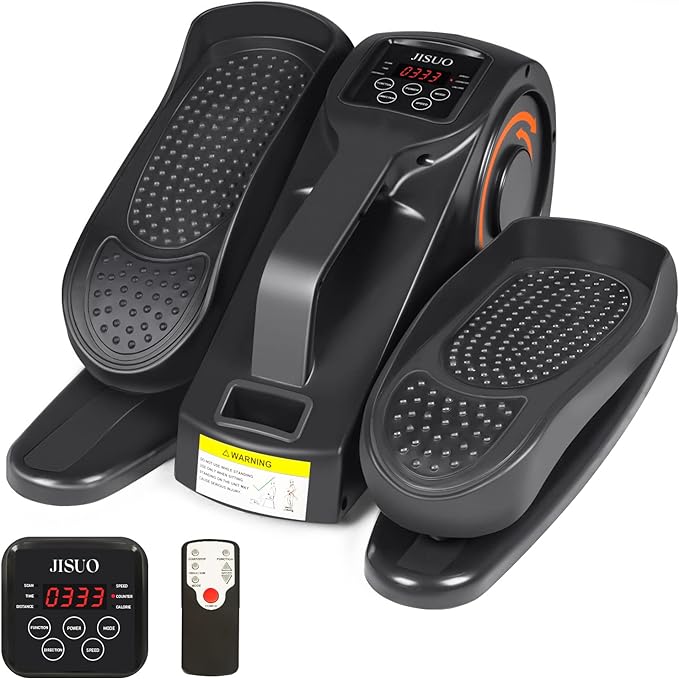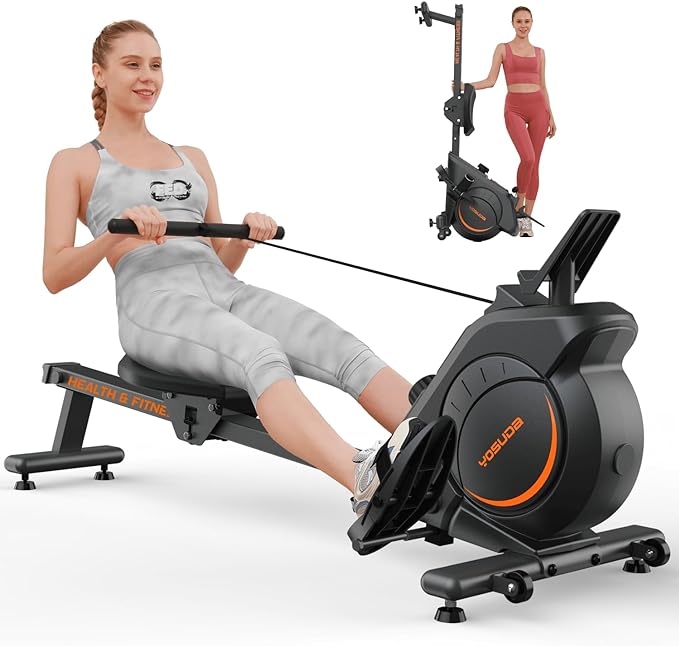In the modern era of remote work and extended desk hours, maintaining a healthy lifestyle can be challenging. One innovative solution to this is integrating exercise into your work routine with the use of desk-compatible cardio machines.
This article reviews the seven best cardio machines designed for desk use, helping you stay fit without compromising your productivity.
Tips for Choosing a Cardio Machine for Desk Use
When selecting a cardio machine for desk use, there are several key factors to consider.
These tips will help you make an informed decision that suits your workspace and fitness goals.
Understand Your Space Constraints
- Assess Your Workspace: Measure the available space under or near your desk to ensure the machine fits comfortably.
- Portability and Storage: Consider how easy it is to move and store the machine, especially in smaller or shared workspaces.
Determine Your Fitness Goals
- Type of Exercise: Decide whether you prefer low-impact exercises like pedaling or something more intense like a mini stepper.
- Target Areas: Some machines focus on lower body movements, while others offer full-body workouts.
Evaluate Machine Features
- Adjustability: Look for machines with adjustable resistance levels to customize your workout intensity.
- Digital Displays: Machines with digital monitors can track your progress, showing metrics like calories burned, distance, and time.
- Noise Level: Since you’ll be using it in a work environment, opt for machines that operate quietly.
Consider Comfort and Ergonomics
- Seating Compatibility: Ensure that the machine is comfortable to use with your office chair.
- Ergonomic Design: Choose a machine that promotes good posture and doesn’t cause strain over extended use.
Check for Compatibility with Your Desk Setup
- Desk Type: Make sure the machine is compatible with your desk, especially if you have a standing desk.
- Space Under Desk: Ensure there’s enough legroom for the machine and your movements.
Quality and Durability
- Build Quality: Invest in a machine that is sturdy and built to last.
- Warranty and Support: Look for products with a good warranty and customer support for any potential issues.
Budget Considerations
- Price Range: Determine your budget and compare features within that price range.
- Cost vs. Quality: Balance between affordability and the quality of the machine.
Read Reviews and Testimonials
- User Experiences: Check customer reviews to gauge the effectiveness and reliability of the machine.
- Expert Opinions: Look for recommendations or reviews from fitness experts.
Health Considerations
- Consult a Professional: If you have any health concerns or existing conditions, consult a healthcare professional before making a choice.
- Low-Impact Options: For those with joint issues, consider low-impact machines like under-desk cycles or ellipticals.
7 Best Cardio Machines for Desk
1. Under-Desk Elliptical Trainer

- Description: Compact and efficient, an under-desk elliptical trainer allows you to pedal smoothly while sitting. It’s a great way to keep your legs moving and improve circulation.
- Key Features: Adjustable resistance, digital monitor, and non-slip pedals.
- Pros: Quiet operation, easy to use, and can be used while sitting or standing.
- Cons: Limited to lower body exercise.
- Price Range: $100-$250
2. Desk Treadmill

- Description: These slim treadmills fit under a standing desk, allowing you to walk while you work. They usually feature a quiet motor and a compact design.
- Key Features: Variable speed settings, space-saving design, and remote control operation.
- Pros: Encourages more movement, good for cardiovascular health.
- Cons: Requires a standing desk and can be expensive.
- Price Range: $300-$800
3. Under-Desk Cycle

- Description: Similar to the elliptical, this machine allows you to pedal under your desk. It’s generally more compact and easier to store.
- Key Features: Resistance levels, digital display, and ergonomic pedals.
- Pros: Improves lower body strength and circulation, quiet.
- Cons: Limited to leg movements.
- Price Range: $50-$200
4. Balance Board

- Description: A balance board is not a typical cardio machine but it can be used at a standing desk to improve core strength and balance while gently moving your body.
- Key Features: Non-slip surface, durable build, and ergonomic design.
- Pros: Enhances core strength, balance, and posture.
- Cons: Requires a standing desk, not a high-intensity cardio workout.
- Price Range: $30-$100
5. Mini Stepper
- Description: A mini stepper is a compact machine that allows you to simulate the motion of stair climbing. It can be used while seated or standing.
- Key Features: Digital monitor, resistance adjustment, and textured pedals.
- Pros: Good for cardiovascular health and lower body toning.
- Cons: Can be challenging to use for extended periods.
- Price Range: $50-$150
6. Seated Elliptical

- Description: Designed for seated use, this machine offers a low-impact elliptical motion. It’s ideal for those who prefer a seated workout.
- Key Features: Smooth gliding motion, adjustable resistance, and quiet operation.
- Pros: Low impact, easy on the joints, can be used while working.
- Cons: Only targets the lower body.
- Price Range: $150-$300
7. Compact Rowing Machine

- Description: Although less common for desk use, a compact rowing machine can be a great option for a full-body workout during breaks.
- Key Features: Foldable design, resistance adjustment, and digital display.
- Pros: Engages multiple muscle groups, good for overall fitness.
- Cons: Requires space and not suitable for use while actively working.
- Price Range: $200-$500
Important Note
“When choosing a cardio machine for desk use, always consider your available space, the type of exercise you enjoy, and any specific health concerns. Additionally, ensure the machine is compatible with your desk setup, especially if using a standing desk.”
Tips for Maintaining Desk-Compatible Cardio Machines
Proper maintenance of your desk-compatible cardio machine not only ensures its longevity but also guarantees a safe and effective workout experience.
Here are some essential tips to keep your machine in top condition.
Regular Cleaning
- Dust and Debris: Regularly wipe down your machine to prevent dust and debris buildup, especially in the moving parts.
- Sanitize Surfaces: Use a gentle disinfectant to clean surfaces, especially if you share the machine with others.
Check for Wear and Tear
- Inspect Regularly: Periodically inspect your machine for any signs of wear, such as frayed cables, loose parts, or unusual noises.
- Replace Parts Promptly: If you notice any worn or damaged parts, replace them immediately to avoid further damage or potential injury.
Lubrication is Key
- Follow Manufacturer Guidelines: Use the recommended lubricant for your machine’s joints and moving parts.
- Routine Lubrication: Regularly lubricate parts to ensure smooth operation and to prevent rust and wear.
Keep It Stable
- Surface Check: Ensure that your machine is placed on a stable, level surface to prevent wobbling or uneven wear.
- Adjust if Necessary: Some machines have adjustable feet or stabilizers – use these to maintain stability.
Monitor Electrical Components
- Power Cords: Regularly check the power cords and plugs for any damage or wear.
- Battery Maintenance: For machines with digital displays or controls, ensure that batteries are replaced as needed.
Avoid Overloading
- Adhere to Weight Limits: Be mindful of the maximum weight capacity of the machine to avoid overstraining it.
- Gentle Use: Avoid aggressive or jerky movements that can strain the machine’s mechanics.
Storage Matters
- Proper Storage: If you need to store your machine, choose a clean, dry area to prevent moisture damage and rust.
- Cover to Protect: Use a cover to protect it from dust and other environmental factors.
Routine Check-ups
- Self-Inspection: Regularly check for any loose screws, bolts, or nuts, and tighten them as needed.
- Professional Maintenance: Consider having a professional service your machine annually, especially for complex machines.
User Manual is Your Friend
- Read the Manual: Familiarize yourself with the manufacturer’s maintenance recommendations.
- Troubleshooting: Use the manual for troubleshooting common issues before calling for professional help.
Be Observant
- Listen for Noises: Pay attention to any unusual sounds during use, as these can indicate internal issues.
- Responsive Action: Address any issues or oddities with your machine as soon as you notice them.
Conclusion
Integrating a cardio machine into your workspace is an innovative way to maintain fitness and boost your productivity. The key is finding a machine that suits your needs, fits your space, and aligns with your fitness goals. Whether it’s a low-impact pedal exerciser or a more engaging mini stepper, there’s an option for everyone.
Remember, staying active even while working can contribute significantly to your overall health and well-being.
Frequently Asked Questions About Desk-Compatible Cardio Machines
Desk-compatible cardio machines have become increasingly popular, especially for those looking to integrate more physical activity into their daily routine.
Here are some common questions and answers about these convenient fitness tools.
Q: What types of cardio machines are suitable for desk use?
A: The most common types include under-desk ellipticals, mini steppers, under-desk cycles, and compact treadmills designed for use with standing desks. Each type offers different benefits and levels of intensity.
Q: Can I really get an effective workout with a desk cardio machine?
A: Yes, desk cardio machines can provide an effective workout, especially for those looking to increase their daily activity levels. They are great for improving circulation, burning calories, and boosting energy, even though they may not replace high-intensity workouts.
Q: Are these machines noisy? Will they disturb my work or coworkers?
A: Most desk cardio machines are designed to be quiet to minimize disturbances in a work environment. However, the noise level can vary between models, so it’s best to check product specifications and reviews.
Q: How much space do I need for a desk cardio machine?
A: This depends on the type of machine. Under-desk models are compact and can fit easily under most desks. Treadmills and larger machines may require more space and are typically suited for use with standing desks.
Q: Are desk cardio machines suitable for weight loss?
A: Desk cardio machines can contribute to weight loss as part of an overall healthy lifestyle. They help increase daily calorie burn, especially for those with sedentary jobs. However, for significant weight loss, they should be combined with a healthy diet and regular exercise.
Q: How do I maintain and clean my desk cardio machine?
A: Regular cleaning with a damp cloth and mild cleanser is recommended to keep your machine free of dust and sweat. Additionally, periodic checks for loose parts and proper lubrication, as per the manufacturer’s instructions, will help maintain its longevity.
Q: Can these machines be used by people of all fitness levels?
A: Yes, most desk cardio machines are suitable for individuals of varying fitness levels. Many offer adjustable resistance or intensity levels to accommodate different fitness needs.
Q: Is it difficult to assemble a desk cardio machine?
A: This varies by model. Some machines come fully assembled, while others require some assembly. Generally, the assembly is straightforward, and most products come with clear instructions.
Q: How do I choose the best cardio machine for my desk?
A: Consider factors like the available space under your desk, the type of exercise you prefer, noise levels, and your fitness goals. Also, think about the machine’s portability and storage, especially if you have a limited workspace.
Q: Are there any health risks associated with using a desk cardio machine?
A: When used properly, these machines are generally safe. However, if you have existing health conditions, particularly related to your joints or cardiovascular system, it’s advisable to consult a healthcare professional before use.